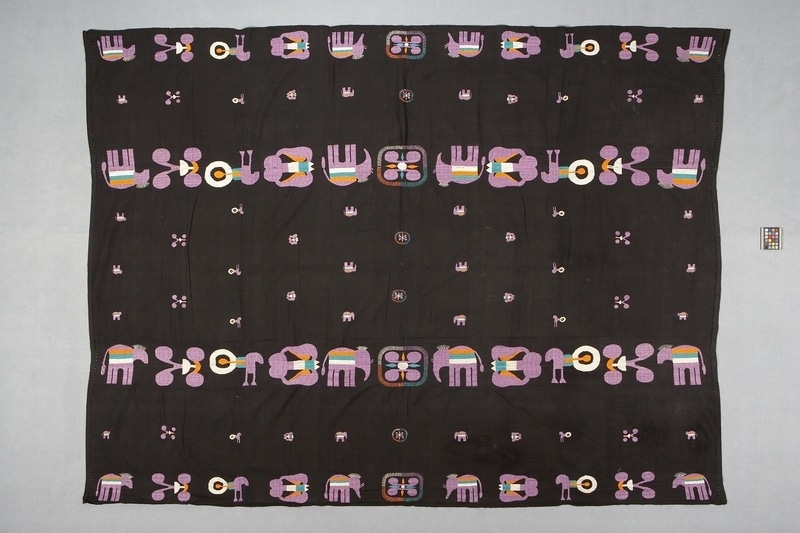Shawl Item Number: Ei26 from the MOA: University of British Columbia

Description
Long rectangular shawl made of three rectangular strips of hand woven black cotton cloth machine stitched together to make one large cloth. There are stylized designs hand embroidered in darning stitch, depicting various sizes of elephant, butterfly, bird and flower-like forms in purple, white, orange and green. Decorative pulled thread open-work border at each end.
History Of Use
This shawl is representative of the woven and embroidered cloths used in Nagaland. Naga shawls have at least one common feature, they are usually three pieces of separately woven cloth sewn together. Traditionally, there was little time for the production of such cloth for market purposes, therefore, women created them for family use only. The cotton was brought into Nagaland and woven by hand on a loin loom. For the embroidery, cotton yarns are purchased in the markets. Formerly cloths of this style were used as shawls (chaddars) but are now produced for outside sale as bedspreads.
Cultural Context
everyday
Iconographic Meaning
The embroidered forms are stylized representations of elephants, birds, butterflies and flowers, the natural life abundant in the area of the Naga Hills.
Item History
- Made in Nagaland, India
- Collected during 1976
- Owned by Stephen Inglis before December 2, 1977
- Received from Museum of Anthropology Donations Fund (Funding source) and Stephen Inglis (Seller) on December 2, 1977
What
- Name
- Shawl
- Identification Number
- Ei26
- Type of Item
- shawl
- Material
- cotton fibre and dye
- Manufacturing Technique
- woven, machine sewn and embroidered
- Overall
- height 240.8 cm, width 176.1 cm
Who
- Culture
- Naga
- Previous Owner
- Stephen Inglis
- Received from
- Museum of Anthropology Donations Fund (Funding source) and Stephen Inglis (Seller)
Where
- Holding Institution
- MOA: University of British Columbia
- Made in
- Nagaland, India
When
- Collection Date
- during 1976
- Ownership Date
- before December 2, 1977
- Acquisition Date
- on December 2, 1977
Other
- Item Classes
- textiles
- Condition
- good
- Accession Number
- 0411/0165